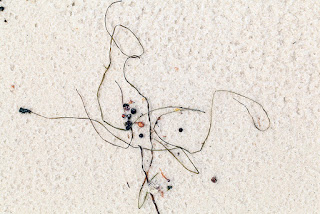That dream seems to mirror my current state as I try to finish my last piece of assessment work for uni. Just when I thought I had nearly finished, there is more to do. Then, when checking some facts, I found more images and maps that need to be added, and the whole document has to be re-indexed etc. One hundred pages is now one hundred and fifteen ... and there is still an essay to finish. Perhaps I need to listen to my dream, ignore the 'cold water' and just do it bit by bit, till I finally get there.
Which brings me to the cockatoos, who also are just 'hanging in there'
 |
| Female Long-billed Black Cockatoo (or Baudin's Cockatoo) - grey eye ring |
So much of their habitat has been cleared over the last one hundred years that they have trouble breeding successfully - both from the point of view of adequate nesting sites and adequate food in the vicinity of the nesting sites. Their favoured habitat is in the high rainfall forests of the south west. They are listed as vulnerable and rare or likely to become extinct, which is a terrible thought. I remember when we lived in Perth, at Men of the Trees (where I was a volunteer) we grew plant species for mass planting in the wheat-belt, specifically as future food and habitat for all the cockatoos. Those plants should now be maturing and paying dividends for the birds.
 |
| Male Long-billed Black-Cockatoo - red eye ring |
Their favoured food are the seeds in the honkey nuts of the Marri and sometimes the blossom. They also eat the seeds of other Eucalyptus and Proteaceae plants. Six years after planting Hakeas we have black cockies visiting to feast on the semi mature seeds. Not only do the hakeas provide seeds for cockies, but they are a haven for little birds that feed on insects and nectar from the flowers. Occasionally the prickly leaved shrub has been a safe nesting site for small honeyeaters.
 |
| Cocky feeding on Hakea protrata seeds |

































